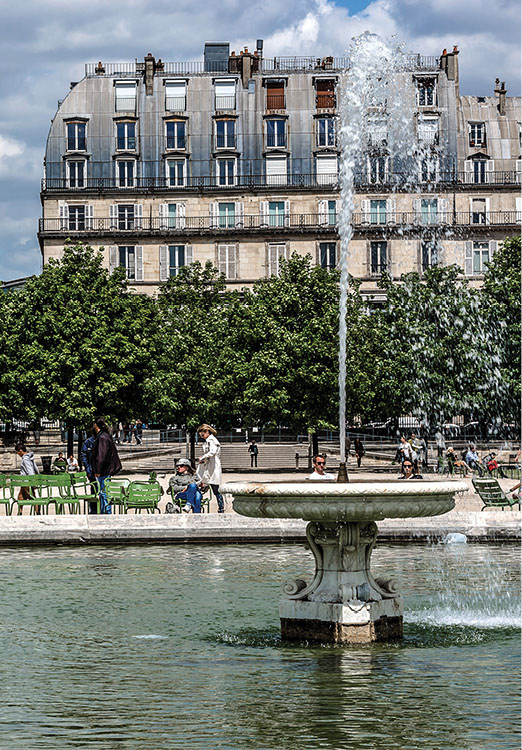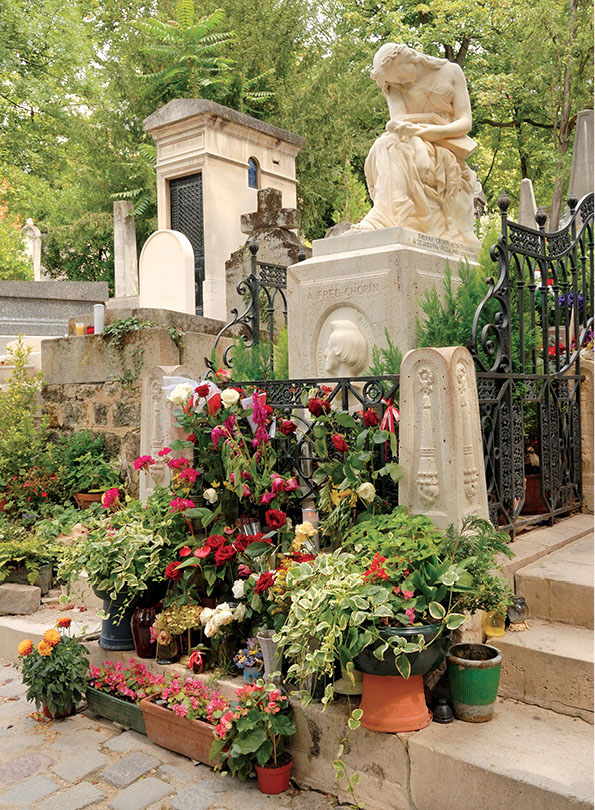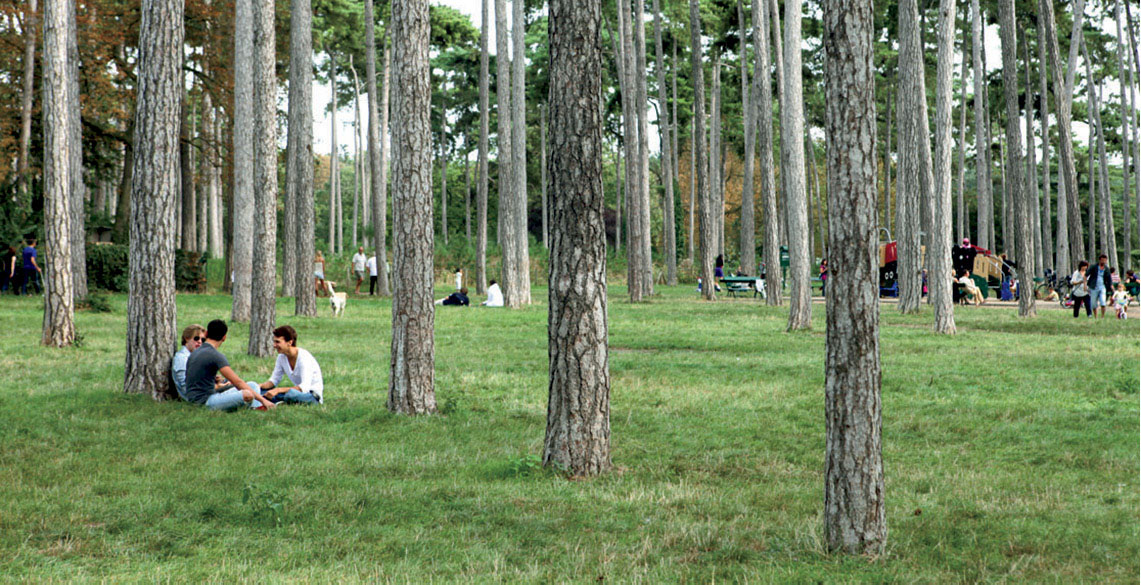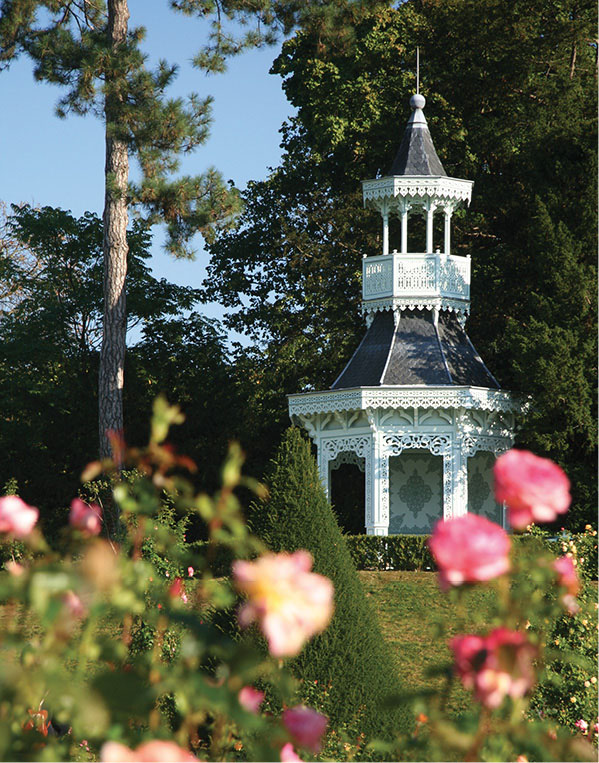The Roue de Paris is a transportable Ferris Wheel that has traveled around the world.
More a statue garden than, as its name implies, a “garden of tiles” (the clay earth here was once used to make roof tiles), the Tuileries stretches from the Louvre all the way down to the Place de la Concorde. Under lacy chestnut trees, paths branch and curl off the dusty main allée, and each seems to hold something to charm you—statues, ice-cream stands, and ponds surrounded by chairs in which you can read or simply relax and contemplate the beauty around you. It’s open daily from 7am to 9pm in summer and from 7am to 5:45pm in winter. START: Métro to Tuileries or Concorde.
❶ Le Jardin du Carrousel. Start by the glass pyramid and walk past the Arc de Triomphe du Carrousel—an elaborate arch ordered by Napoleon in 1806 and copied from the Septimus Severus Arch in Rome—into the eastern edge of the Tuileries, the Jardin du Carrousel. (Just so you know, the last word refers to equestrian exhibitions—there’s no merry-go-round here.) The gold-tipped obelisk you see gleaming at the end (the Luxor Obelisk, a gift from Egypt) marks the Place de la Concorde. Look around and you’ll find beautiful boxwood hedges, among which 20 graceful statues by Aristide Maillol seemingly play hide and seek.
❷ Rodin Statues. Keep walking until you cross Avenue du Général-Lemonnier. Four typically graceful statues by Auguste Rodin (The Kiss, Eve, Meditation, and The Shadow) flank the paths. The glimmering golden statue in the distance at Place des Pyramides is Joan of Arc; she assembled her army against the British from a spot not far from here, on Avenue de l’Opéra.
❸ Grande Allée. Off to the sides of the Grande Allée, a number of modern statues peek at you from the greenery—Henry Moore’s Figure Couchée lounges leisurely, and Alberto Giacometti’s Grande Femme II sits near Jean Dubuffet’s dazzling Le Bel Costume. Particularly beguiling is The Welcoming Hands—a collage of intertwined hands, by Louise Bourgeois.
❹ Octagonal “Grand Bassin.” The statues surrounding this pond date from the days when this was a royal park fronting the ill-fated Palais Tuileries, which burned to the ground during a battle in 1871. The statues are all allegories—of the seasons, French rivers, the Nile, and the Tiber.

The Grand Bassin in the Jardin des Tuileries is surrounded by statues.
❺ Coysevox Statues. At the end of the garden, at the gates facing the Place de la Concorde, are copies of a set of elaborate statues originally created by Charles-Antoine Coysevox (1640–1720), one of Louis XIV’s sculptors. They depict the gods Mercury and Fame riding winged horses.
Père-Lachaise became one of the world’s most famous cemeteries when Jim Morrison died (or didn’t die, as some fans believe), in 1971. Almost immediately, Morrison’s grave became a site of pilgrimage and the place filled with tourists, most of whom you can avoid if you stay away from Morrison’s grave. Aside from its VIP RIPs, Père Lachaise is a peaceful place to get away from the hubbub of city life. It’s also a magnet for lovers of sculpture, who can admire some of Europe’s most intricate and beautiful 19th-century tombstones. START: Métro to Philippe-Auguste or Père Lachaise.
❶ Main Entrance. Start by picking up a free map at the gate. 8 bd. de Ménilmontant. ☎ 01-55-25-82-10. Free admission. Daily 8am (8:30am Sat, 9am Sun & public holidays) to 6pm (until 5:30pm in winter). Métro: Philippe-Auguste or Père-Lachaise.
❷ Colette. French writer Sidonie-Gabrielle Colette published 50 novels. Her most famous story, Gigi, became a successful Broadway play and film. When she died in 1954, she was given a state funeral but was refused Roman Catholic rites because of her naughty lifestyle. Section 4.
❸ Gioacchio Antonio Rossini. The Italian composer is best known for the operas The Barber of Seville and William Tell, the overture of which is one of the most famous in the world. His dramatic style led to his nickname among other composers—“Monsieur Crescendo.” Section 4.
❹ Héloïse & Abelard. If you turn right down Avenue du Puits, near Colette’s grave, you’ll soon come to the oldest inhabitants of the cemetery. These star-crossed medieval lovers were kept apart their entire lives by Héloïse’s family. Their passionate love letters to one another were published and have survived the ages. Abelard died first. Local lore maintains that when Héloïse died, a romantic abbess opened Abelard’s grave to put Héloïse’s body inside, and his corpse opened its arms to embrace his long-lost love. Section 7.
❺ Jim Morrison. If you must visit Morrison’s grave, follow the crowds. The bust that once stood at the head of the tomb was stolen years ago by one of his “fans.” The cigarette butts stubbed out on the grave are also courtesy of his “fans.” As are the graffiti and the stench of old beer. What a mess. Section 6.
❻ Frédéric Chopin. Retrace your steps across Avenue Casimir-Périer to section 11, where you’ll find the elaborate grave of the piano maestro marked with a statue of Erato, the muse of music. Section 11.

Famed pianist Frédéric Chopin’s tomb.
❼ Georges Bizet. The 19th-century composer of the impossibly infectious opera Carmen died 3 months after the premiere of his most famous work, convinced it was a failure. Section 68.
❽ Honoré de Balzac. The passionate French novelist wrote for up to 15 hours a day, drinking prodigious quantities of coffee to keep him going. His writing was often sloppy and uninspired, but it makes an excellent record of 19th-century Parisian life. Section 48.
❾ Eugène Delacroix. This dramatic and intensely romantic painter’s Liberty Leading the People is a lesson in topless inspiration. In stark contrast, his tomb is sobriety incarnate: just a dark stone sculpture shaped like a coffin and decorated with a single row of white-centered flowers. Section 49.
❿ Marcel Proust. The wistful 19th-century novelist died before he could finish editing his famous series of books, A la Recherche du Temps Perdu (In Search of Lost Time), yet he’s considered one of the world’s great writers. Section 85.
⓫ Isadora Duncan. The tragic death of this marvelous modern dancer is legendary—she favored long, dramatic scarves and convertibles, and one day one of those wrapped around the other and that was the end of Isadora. Section 87.
⓬ Oscar Wilde. The bluntly named Avenue des Etrangers Morts pour la France (Avenue of Dead Foreigners, basically) leads to the fantastical tomb of this gay 19th-century wit and writer. The size of the member with which the statue atop the grave was equipped was quite the buzz in Paris until a vengeful woman knocked it off. Section 89.
⓭ Gertrude Stein. The early-20th-century writer, art collector, and unlikely muse shares a simple double-sided tomb with her longtime companion, Alice B. Toklas. Section 94.
⓮ Edith Piaf. Just one more stop before you collapse—the resting place of famed French songbird Edith Piaf, beloved by brokenhearted lovers and gay men everywhere. Section 97.
 Exit. If possible, leave the cemetery at Rue de la Réunion (this exit sometimes closes early), and from there head right down Rue de Bagnolet to the Alexandre Dumas Métro station. On the way, shabby-chic bar Piston et Pélican is perfect for a glass of wine alongside arty crowds. Stay after 9pm for live music. 15 rue de Bagnolet, 20th. ☎ 01-43-71-15-76. www.pistonpelican.com. Open from 5pm.
Exit. If possible, leave the cemetery at Rue de la Réunion (this exit sometimes closes early), and from there head right down Rue de Bagnolet to the Alexandre Dumas Métro station. On the way, shabby-chic bar Piston et Pélican is perfect for a glass of wine alongside arty crowds. Stay after 9pm for live music. 15 rue de Bagnolet, 20th. ☎ 01-43-71-15-76. www.pistonpelican.com. Open from 5pm.
This former forest, once used for royal hunts, has two personalities. By day, it’s a family park where children gambol and ride ponies, while walkers and cyclists take in the beauty of its lakes and waterfalls. By night, it’s one of the city’s busiest prostitution districts and a hub for other nefarious activities, so make sure you get out before sundown. While you’re there, however, you’re in for a bucolic day amid birds, woodlands, and 19th-century tropical greenhouses. Between May and September, you can even take in classical theater (in English and French) among the sweet-scented roses of the Jardin de Shakespeare. START: RER to Avenue Foch.
❶ Lac Inférieur. Most easily accessed by way of Avenue Foch, this unfairly named lake (it’s the larger of the two) has two picturesque islands connected by fanciful footbridges. You can rent a boat and paddle across to the islands’ cafes and restaurants. On a hot summer day, it’s also a perfect spot for a picnic.
❷ Carrefour des Cascades. The scenic walkway between the upper and lower lakes is an attraction in itself, with willows dipping their branches languorously in the water, and a handsome, manmade waterfall creating a gorgeous backdrop. You can even walk under the waterfall.
❸ Lac Supérieur. The smaller of the two lakes has more of everything you find on the larger lake, with lots of boats to paddle and several restaurants and cafes dotted about.

Bois de Boulogne is known as the green lung of the French capital.
Bois de Boulogne: Practical Matters
Bois de Boulogne is open daily from dawn to dusk. Because it’s such a large park, there are several entrances and several public transportation options. Nearby Métro stops include Les Sablons (north, on av. Charles de Gaulle), Porte Maillot (northeast, on av. de la Grande Armée), Porte Dauphine (northeast, on av. Foch), or Porte d’Auteuil (southeast, on av. de la Porte d’Auteuil). Take the RER to Avenue Foch or Avenue Henri Martin. In the park are numerous cafes and restaurants. A miniature train runs to the Jardin d’Acclimatation from Porte Maillot—a fun touch for kids. You won’t be able to do the whole of the Bois in one day, but to see a maximum of sites, do as Parisians do, and grab a self-service Vélib’ bike for the day (1.70€, then free for 30 minutes; see p 168). There’s a handy bike station near the park’s entrance at Porte Maillot: no. 16003 at 2 bis boulevard André-Maurois.
❹ Hippodrome de Longchamp. If your euros are burning a hole in your pocket, head to the southern end of the park, where two horse-racing courses—the excellent Hippodrome de Longchamp and the smaller Hippodrome d’Auteuil (see next stop)—offer galloping action. The Grand Prix held at Longchamp each June is a major derby and gets the ladies out to the track in their finest hats. Route des Tribunes, 16th. ☎ 01-44-30-75-00. www.france-galop.com. Métro: Porte Maillot then bus 244 and get off at Carrefour de Longchamp.
❺ Hippodrome d’Auteuil. This racetrack, the smaller of the two in Bois de Boulogne, is known for its heart-pounding steeplechases and obstacle courses. Route d’Auteuil aux Lacs, 16th. ☎ 01-40-71-47-47. www.france-galop.com. Métro: Porte d’Auteuil-Hippodrome.
❻ Parc de Bagatelle. In the shadow of a bijou château built for Marie-Antoinette, this romantic 18th-century park-within-a-park in the northwest of Bois de Boulogne is a riot of colorful tulips in spring, and the rose garden blooms spectacularly by late May. A sequence of little bridges, grottoes, and water features also make it one of Paris’s most popular trysting spots. ☎ 01-40-67-97-00. Métro: Porte d’Auteuil or Jasmin.

Romantic Parc de Bagatelle.
❼ ★★  Jardin d’Acclimatation. Those with small children may want to head straight to this amusement park on the north end of Bois de Boulogne, which boasts colorful rides, a small zoo, and a kid-size train. See p 29, ❻.
Jardin d’Acclimatation. Those with small children may want to head straight to this amusement park on the north end of Bois de Boulogne, which boasts colorful rides, a small zoo, and a kid-size train. See p 29, ❻.
❽ ★ Fondation Louis-Vuitton. Architect Frank Gehry’s latest Parisian creation—all futuristic glass and metal sails—is stunningly incongruous when seen emerging through the Bois de Boulogne’s tree-lined paths. Inside, expect cutting-edge art exhibitions by a plethora of international names, and contemporary classical music concerts. See p 43, ❺.
❾ ★★ Jardin de Shakespeare. This has to be one of the most beautiful open-air theaters in the world—a lawn encircled by bright, buzzing flowerbeds and draping trees. Every summer, it becomes the idyllic stage for Shakespeare and classical French children’s theater productions. In the Jardin Pré-Catelan. www.jardinshakespeare.com. Métro: Porte de la Muette. 